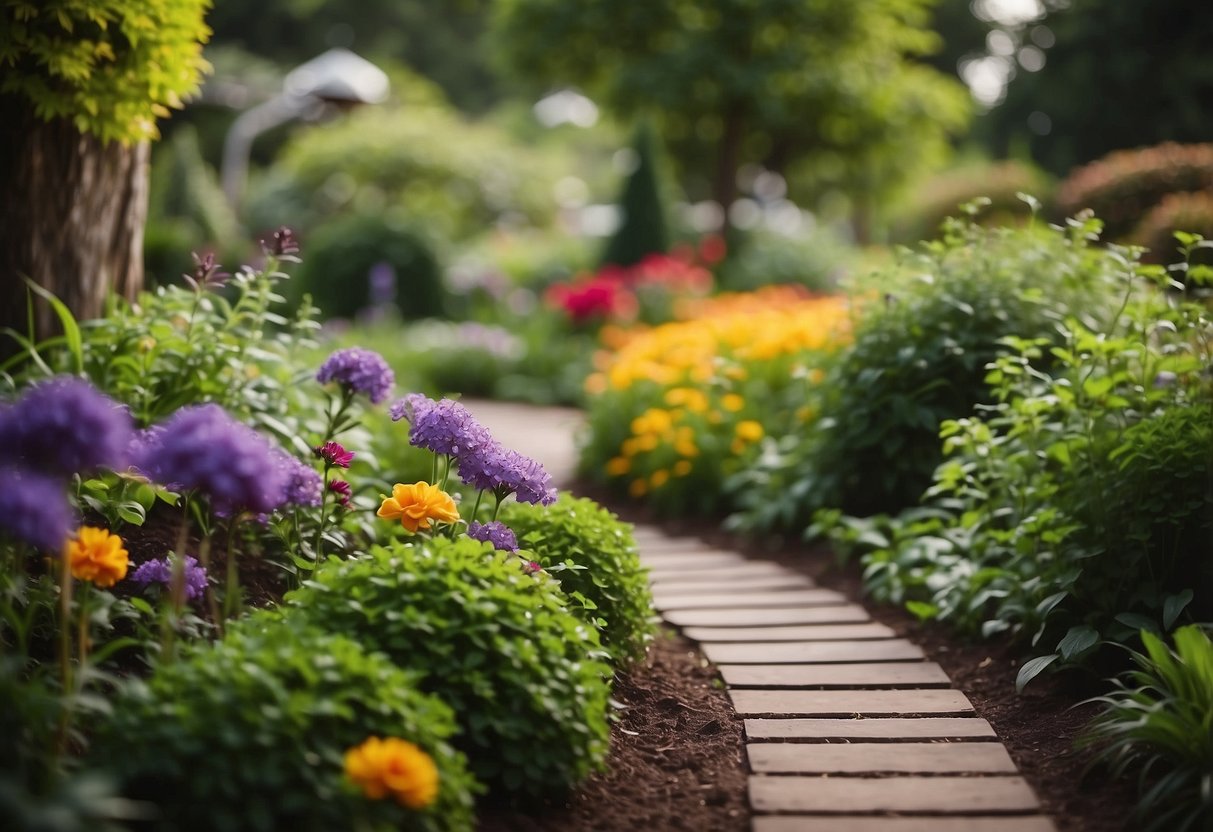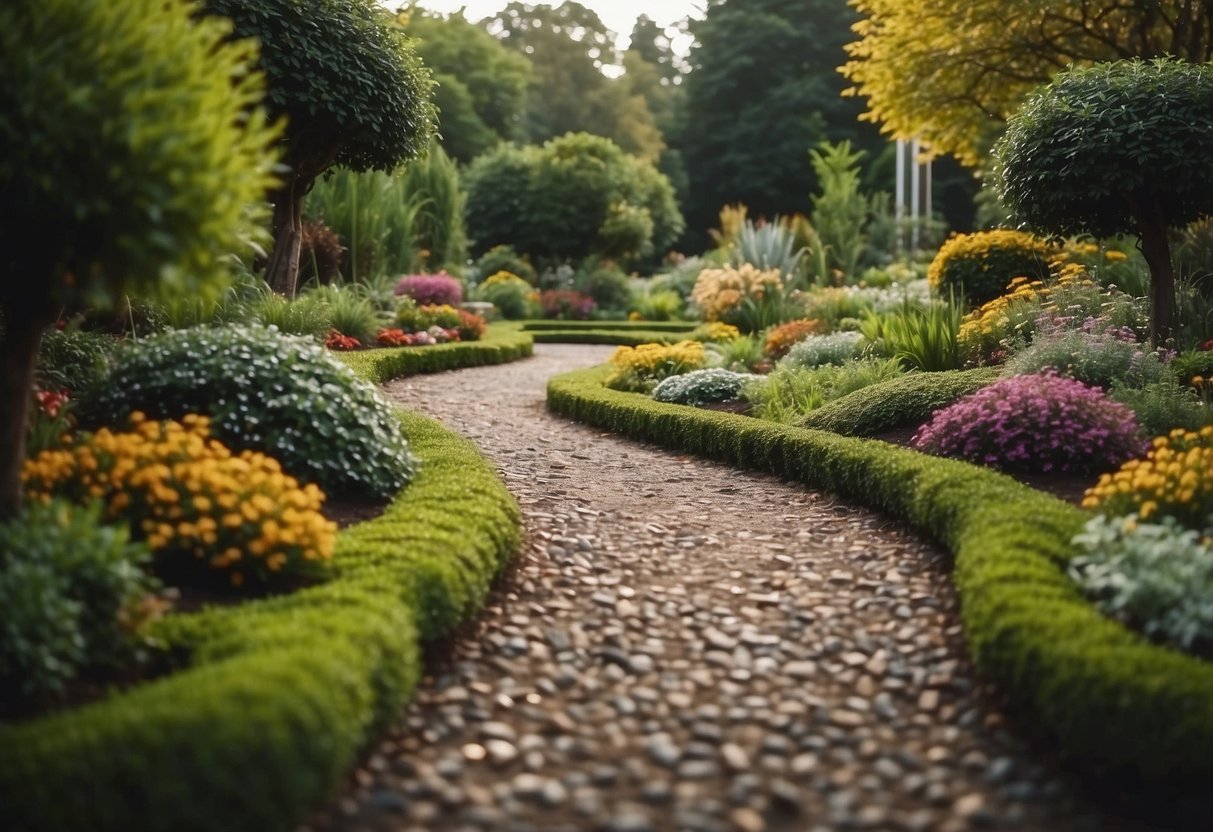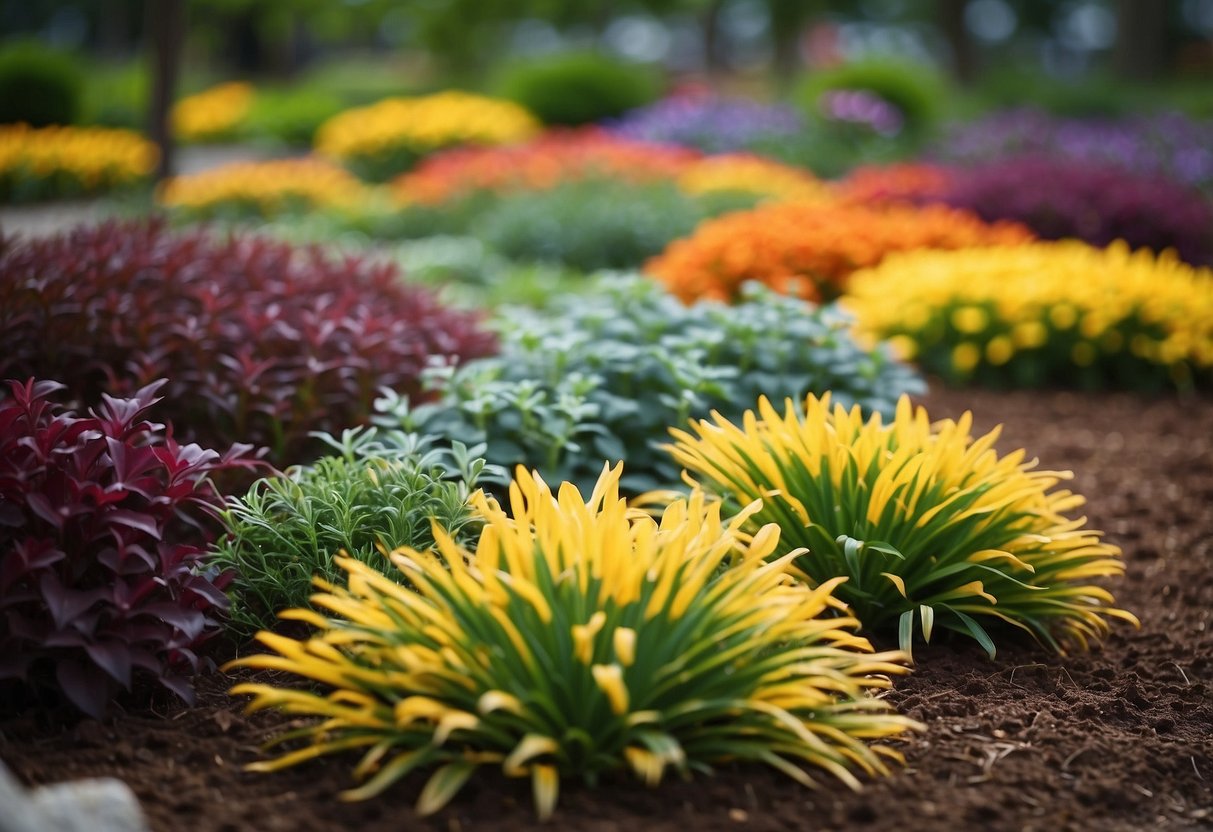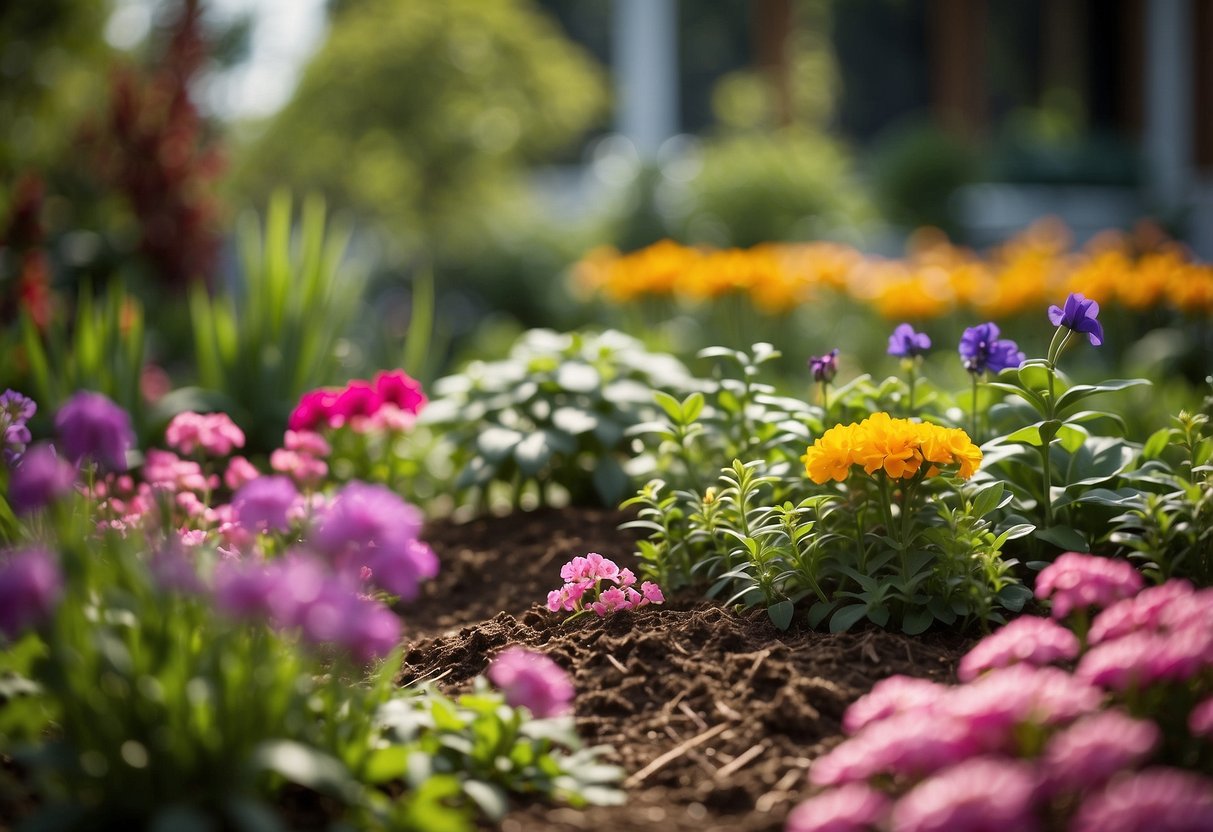Mulch Garden Ideas: Simple Tips for a Gorgeous Yard
Gardening with mulch can transform your garden into a healthy and vibrant space. It not only helps retain moisture but also suppresses weeds and improves soil quality. Whether you’re a seasoned gardener or just starting, adding mulch can make a big difference.

How can you pick the right mulch for your garden? There are various types of mulch to choose from, each with its benefits. Exploring different options can help you find the best fit for your gardening needs and aesthetic preferences.
1) Use Recycled Newspaper

You can use old newspapers as a mulch for your garden. Simply lay down a couple of layers of the newspaper and then cover it with leaves or grass.
This method helps keep weeds at bay and retains soil moisture. Plus, it’s an eco-friendly way to recycle paper.
Newspaper mulch is also free if you already have old papers around the house.
Learn more about the benefits of newspaper mulch.
2) Decorative Gravel Pathways

Decorative gravel adds charm to your garden while being practical. It creates a clean, natural look and is easy to maintain.
You can choose from different types like pea gravel, crushed stone, or decomposed granite. Each type offers its own unique texture and color.
Incorporate edging to keep the gravel in place and define the pathway. It helps in creating neat borders that enhance the garden’s aesthetics.
Adding stepping stones to your gravel path adds interest and makes walking easier. Combine gravel with other garden elements to create a cohesive and inviting outdoor space.
3) Colorful Bark Mulch

Colorful bark mulch can transform your garden with vibrant shades. It not only suppresses weeds but also adds visual interest to your landscape.
You can find options in red, brown, black, and even gold. This mulch is made from shredded tree bark and is great for improving soil.
Use colorful bark mulch to highlight garden paths or flower beds. It brings a bright, cheerful feel to outdoor spaces.
4) Pine Straw Bedding

Pine straw is a great mulch option for your garden. It’s made from fallen pine needles, which are lightweight and easy to spread. You can find it readily available and it’s often cheaper than other mulches.
Using pine straw helps retain soil moisture and keeps the ground cool. This is beneficial for plants during hot weather. Additionally, it allows water to pass through easily, preventing soil erosion.
When applying pine straw, keep it 2 to 3 inches away from the base of plants and tree trunks to prevent rodent damage. Spread it evenly to ensure good coverage and refresh it as needed. For more information, visit Bob Vila’s guide.
5) Rubber Tire Mulch

Rubber tire mulch is an innovative and eco-friendly option for your garden. Made from recycled tires, it helps reduce landfill waste while providing excellent ground coverage.
It offers great insulation for plant roots, helping them stay cool in the summer and warm in the winter. This mulch also discourages pests, making your garden healthier.
This type of mulch is almost maintenance-free. It doesn’t break down quickly, so you won’t need to replace it as often as other mulches. For detailed steps on how to apply it, check out this guide on using rubber mulch.
6) Composted Leaves

Using composted leaves in your garden is a fantastic way to enrich the soil. You can create compost by mixing four to five parts leaves with one part green waste.
Turn the pile 1-2 times a week to aerate it. This will help speed up the composting process.
Occasionally add more green waste, like grass clippings or kitchen scraps.
For more information, you can read this guide on composting leaves.
7) Straw and Hay Mulch

Using straw and hay as mulch can be a great choice for your garden. Straw, usually made from grains like wheat or oats, helps keep weeds down and promotes soil health.
When you use hay, make sure to create a thick layer, about 8 inches deep. Push your seeds or starters right into this layer for easy planting.
Both straw and hay help keep the soil moist and prevent erosion. Straw is ideal for garden pathways, while hay works well in garden beds. Water the mulch lightly to keep it in place.
For more details, you can read on mulching with hay and using straw mulch for vegetable gardening.
8) Grass Clippings Mulch

Grass clippings make an excellent mulch for your garden. They help retain soil moisture and prevent weeds from sprouting.
When using fresh clippings, keep the layer thin to avoid mold. Aim for about ¼ inch thick.
You can also use dry grass clippings, applying them a bit thicker for better coverage. Using grass clippings as mulch will enrich your soil as they decompose.
9) Shredded Hardwood

Shredded hardwood is a popular mulch choice for gardens. It’s biodegradable, so it enriches your soil as it breaks down.
This type of mulch is easy to find at garden centers and hardware stores. It has a nice, earthy smell that many people enjoy.
Shredded hardwood also looks great and can fit into various garden styles. Take advantage of this mulch for a versatile and practical garden addition.
10) Cocoa Bean Hulls

Cocoa bean hulls are a great mulch option for your garden. These shells come from the process of making chocolate, making them sustainable and earth-friendly.
They help retain soil moisture, keeping your garden hydrated. Cocoa hulls also look attractive with their rich, dark color.
An additional benefit is the nutrients they provide. Cocoa hulls contain nitrogen, which boosts soil fertility. Plus, they slowly decompose, adding organic matter to the soil over time. Be mindful if you have pets, as cocoa mulch can be harmful to dogs.
Benefits of Using Mulch in Your Garden

Using mulch in your garden can significantly improve plant health and reduce maintenance time. Key benefits include retaining moisture, suppressing weeds, and regulating soil temperature.
Moisture Retention
One major advantage of mulch is its ability to retain moisture in the soil. By covering the soil, mulch reduces water evaporation, which means you need to water your plants less frequently. It acts like a protective barrier, helping the soil stay damp longer, especially during hot, dry periods.
Organic mulches, like straw or wood chips, are particularly effective. They absorb water and slowly release it into the soil. This helps maintain consistent soil moisture levels, which is crucial for healthy plant growth. Moisture retention also supports beneficial soil organisms, creating a richer, healthier soil environment.
Weed Suppression
Mulch is very effective at suppressing weeds. By covering the ground, mulch blocks sunlight from reaching weed seeds, preventing them from germinating and growing. This means you spend less time weeding and more time enjoying your garden.
Materials like grass clippings or shredded leaves are great for this. They create a dense layer that weeds struggle to penetrate. Keep the mulch layer thick enough—about 2-3 inches—to ensure it effectively suppresses unwanted plants. Using mulch reduces the need for chemical herbicides, making your garden more eco-friendly.
Soil Temperature Regulation
Mulch helps regulate soil temperature, keeping it cool in the summer and warm in the winter. By insulating the soil, mulch mitigates temperature fluctuations that can stress plants. This steady environment is conducive to robust plant development.
In summer, mulch shields the soil from direct sunlight, preventing it from overheating. In winter, it acts as a blanket, protecting roots from freezing temperatures. Organic materials, such as hay or compost, are particularly effective as they break down and add nutrients to the soil, further promoting plant health.
Using mulch not only enhances your garden’s appearance but also provides these practical benefits, making it a valuable addition to your gardening routine.
Types of Mulch for Gardens

Choosing the right type of mulch for your garden can improve soil health, reduce water needs, and keep weeds at bay. There are two main types of mulch: organic and inorganic, each with their unique benefits.
Organic Mulch
Organic mulch includes materials that decompose over time, adding nutrients back into the soil. Examples include compost, wood chips, and grass clippings. Compost is rich in nutrients and helps improve soil structure. It’s great for vegetable gardens.
Wood chips break down slowly and are good for paths and around trees and shrubs. They also help retain soil moisture. Grass clippings are high in nitrogen and perfect for garden beds. They decompose quickly, improving soil fertility.
Leaves and straw are other options. Leaves add organic matter to the soil and are readily available in fall. Straw is great for keeping soil cool and moist, making it ideal for vegetable gardens.
Inorganic Mulch
Inorganic mulch does not decompose and lasts longer than organic mulch. Examples include gravel, pumice rock, and plastic mulch. Gravel and pumice rock are effective for pathways and around succulents or cacti. They provide excellent drainage and do not break down.
Plastic mulch is commonly used in commercial farming to retain soil moisture and control weeds. It can be black or clear and is placed directly on the soil. Rubber mulch from recycled tires is durable and great for playgrounds or ornamental garden beds.
Each type of mulch has its benefits, so choose the one that best suits your garden’s needs.
How to Apply Mulch Correctly

To apply mulch the right way, you’ll need to focus on preparing the area, applying the mulch in layers, and knowing when to reapply it. Here’s a step-by-step guide to help you get it right.
Preparation Steps
Begin by clearing the area of weeds and debris. This ensures that mulch can do its job without any obstacles. Use a shovel or wheelbarrow to remove old mulch or other materials. Rake the soil to make it smooth and even.
For extra weed control, you can add a layer of plastic mulch or fabric landscape sheeting. This will prevent new weeds from sprouting up through the mulch. Make sure the sheeting covers the whole area but leaves space around stems or trunks.
Key Items:
- Shovel
- Wheelbarrow
- Rake
- Plastic mulch or fabric landscape sheeting
Layering Techniques
Start by dumping small piles of mulch across the prepared area. This makes spreading easier and more even. Use a rake to spread the mulch evenly, keeping the layer between 2-4 inches thick. Mulching too thin won’t block weeds, and too thick will suffocate plant roots.
Avoid piling mulch against tree trunks or plant stems. This can cause moisture buildup and lead to rot. Instead, create a small ring around the base, leaving some space for air circulation.
Steps:
- Dump small mulch piles.
- Spread with a rake.
- Keep layer 2-4 inches thick.
- Avoid trunks and stems.
Frequency of Reapplication
Mulch breaks down over time, so you’ll need to check it every few months. Organic mulches like wood chips and straw will decompose faster and may need replenishing more often.
Typically, you should refresh your mulch every spring and fall. This not only keeps your garden looking neat but also ensures the mulch continues to suppress weeds and retain soil moisture.
Timing:
- Check mulch every few months.
- Reapply each spring and fall.
By following these steps, you’ll keep your garden healthy and looking great!







